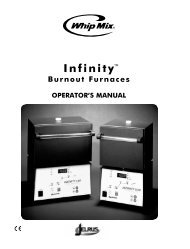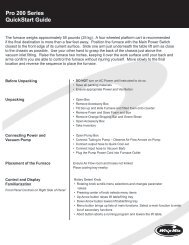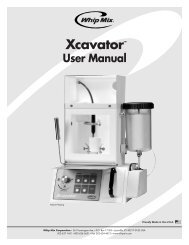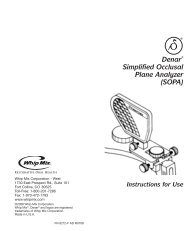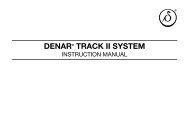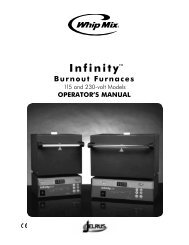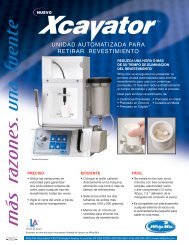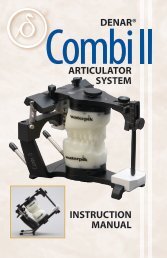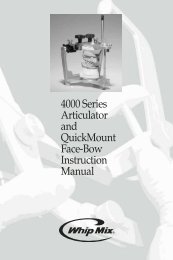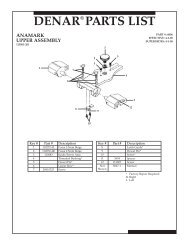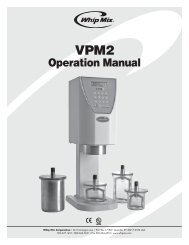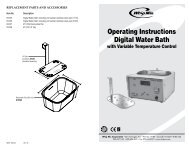Mark II Instruction Manual - Whip Mix
Mark II Instruction Manual - Whip Mix
Mark II Instruction Manual - Whip Mix
Create successful ePaper yourself
Turn your PDF publications into a flip-book with our unique Google optimized e-Paper software.
error was not introduced in the laboratory.<br />
He can then re-evaluate his procedure<br />
to determine the source of error.<br />
In other words, if the restoration fits the<br />
mounted casts but not the mouth, the<br />
technician cannot be expected to participate<br />
in the additional cost of remakes<br />
not attributed to laboratory procedures.<br />
CLASSIFICATIONS OF<br />
OCCLUSAL CARVINGS<br />
The following classification of occlusal<br />
carvings as illustrated in figure 82 enables<br />
the dentist to specify to the laboratory<br />
the relative amount of time and effort<br />
he desires the laboratory to expend (and<br />
consequently the laboratory fee) to fabricate<br />
the prescribed occlusion.<br />
Alloy Restorations<br />
Class A – Refined Occlusal Carving<br />
The restoration is fabricated in the manner<br />
the technician might employ when<br />
using a simple crown and bridge hinge<br />
mechanism. When the occlusion is<br />
semi-developed, the technician simply<br />
bruxes the instrument to burnish away<br />
eccentric interferences and refines the<br />
anatomy of the remaining wax. Eccentric<br />
irritations are removed from the<br />
occlusion in the laboratory. This is the<br />
application of principles of occlusion in<br />
its simplest form and consequently is a<br />
minimum fee laboratory service.<br />
Class AA – Modified Drop Wax<br />
Basically, this is a Class A carving<br />
with more refinement. The technician<br />
carves in supplemental grooves and<br />
then accentuates triangular, cuspal and<br />
marginal ridges with the drop wax technique.<br />
The ultimate appearance will be<br />
similar to a Class AAA carving. A Class<br />
AA carving requires more laboratory<br />
time than a Class A carving and so the<br />
laboratory fee should reflect 10% to<br />
30% increase in the labor factor of the<br />
Class A carving.<br />
fig. 82<br />
Class AAA – Complete Drop Wax<br />
The drop wax technique is employed to<br />
restore the total occlusal surface and<br />
all restored axial surfaces to obtain the<br />
maximum esthetic cusp height, optimum<br />
cusp distribution, and to harmonize<br />
the occlusal anatomy with condylar<br />
paths of movement. This type of occlusal<br />
fabrication requires more time and<br />
skill than a Class A or Class AA carving<br />
and consequently the laboratory<br />
fee reflects a 50% to 100% increase in<br />
the labor factor of a Class A carving.<br />
However, this can only be done on a<br />
restoration involving extensive tooth reduction.<br />
For example, if the restorations<br />
are MOD inlays or onlays with minimum<br />
tooth reduction, the cusp distribution<br />
has already been accomplished and the<br />
laboratory only needs to do the fill-inprocedures<br />
of the drop wax technique.<br />
Consequently, a Class AA or AA+ carving<br />
would suffice.<br />
Centric Contacts<br />
The character of the centric contacts<br />
must produce axial loading of the teeth.<br />
This can be accomplished by:<br />
1. Point Contact (•). There is an absence<br />
of contacting inclines. Centric<br />
stops are on high spots or low<br />
spots of cusps.<br />
43



